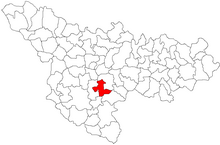Darling (romania)
| favorite | ||||
|
||||
| Basic data | ||||
|---|---|---|---|---|
| State : |
|
|||
| Historical region : | Banat | |||
| Circle : | Timiș | |||
| Coordinates : | 45 ° 35 ′ N , 21 ° 19 ′ E | |||
| Time zone : | EET ( UTC +2) | |||
| Height : | 91 m | |||
| Area : | 82.26 km² | |||
| Residents : | 3,723 (October 20, 2011) | |||
| Population density : | 45 inhabitants per km² | |||
| Postal code : | 307245 | |||
| Telephone code : | (+40) 02 56 | |||
| License plate : | TM | |||
| Structure and administration (as of 2016) | ||||
| Community type : | local community | |||
| Structure : | Darling, Cerna , Iosif | |||
| Mayor : | Ioan Gheorghe Munteanu ( PNL ) | |||
| Postal address : | Strada Principală, no. 528 loc. Darling, jud. Timiș, RO-307245 |
|||
| Website : | ||||
Liebling ( German , Romanian and Hungarian ; Hungarian also Kedvencz ) is a municipality in Timiș County , in the Banat region , in southwest Romania , about 30 km south of the county capital Timișoara ( Timisoara ).
Neighboring places
| Pădureni | Urseni | Sacoșu Turcesc |
| Jebel |

|
Nițchidorf |
| Voiteg | Birda | Șipet |
location
Liebling is on the edge of the Banat hill country on the DJ 69 road halfway between Timișoara and Deta and on the Jebel-Liebling railway line . The municipality belongs to the Timiș County. Liebling is around 76 meters above sea level .
history
The village is located in the Banat and was created in 1786 during the third great Swabian campaign under Joseph II and settled with Protestants . Liebling was the first Protestant settlement in the Banat.
The place name goes back to the camera administrator Nikolaus Freiherr von Vecsey. The colonial commissioner Walbrun wanted to name the place Veczehaza in his honor. Baron von Vecsey refused this honor and replied: No, it should be called darling, because the Protestants are my favorites.
The Protestant church was completed in 1823. In 1835 the Protestant communities in the Banat founded their own church district. In 1841 the Protestant school was built. In 1845 the Roman Catholic parish was founded in Liebling. After Liebling fell to Romania as a result of the Treaty of Trianon , 16 Romanian families were settled here in 1926.
On June 4, 1920, the Banat was divided into three parts as a result of the Treaty of Trianon . The largest, eastern part, which also included Liebling, fell to Romania.
In 1941 Liebling had 5086 inhabitants, 886 of them Romanians and 4086 Germans. On September 22nd, 1944, 2,158 German residents from Liebling fled westwards from the approaching Soviet army . In October they arrived in the Braunau area , where they were quartered in the surrounding villages. More than a hundred darlings were deported to Russian labor camps in January 1945 , in which almost half were killed. After 1945, the communist government settled more than 2000 Romanians in the empty houses. In 2002 Liebling had 3744 inhabitants, of which 3362 were Romanians and 22 Germans.
The Land Reform Act of March 23, 1945 , which provided for the expropriation of German farmers in Romania, deprived the rural population of their livelihoods.
economy
In 1994 the Romanian-Italian trading company "BRIST PAN" was founded in Liebling, producing baked goods and dairy products. Italian ovens are said to bake 3,500 breads a day. The commissioning of our own mill was planned for a later date. In the cheese department , butter and various types of cheese are to be produced, including the well-known mozzarella . For this purpose, 2,000 liters of milk should be processed daily. In the third department, ten types of biscuits, pizza, cake sheets and grisines are to be produced.
See also
literature
- Elke Hoffmann, Peter-Dietmar Leber and Walter Wolf : The Banat and the Banat Swabians. Volume 5. Cities and Villages , Media Group Universal Grafische Betriebe Munich, Munich 2011, ISBN 3-922979-63-7 .
Web links
- Private website about Liebling im Banat
- Favorite in the web presentation of the Timiș County Council
Individual evidence
- ↑ 2011 census in Romania at citypopulation.de
- ↑ Mayoral elections 2016 in Romania ( MS Excel ; 256 kB)
- ↑ banater-aktualitaet.de ( Memento of the original from December 18, 2007 in the Internet Archive ) Info: The archive link was inserted automatically and has not yet been checked. Please check the original and archive link according to the instructions and then remove this notice. , Anton Zollner: Through former German villages of the Banat. favorite



